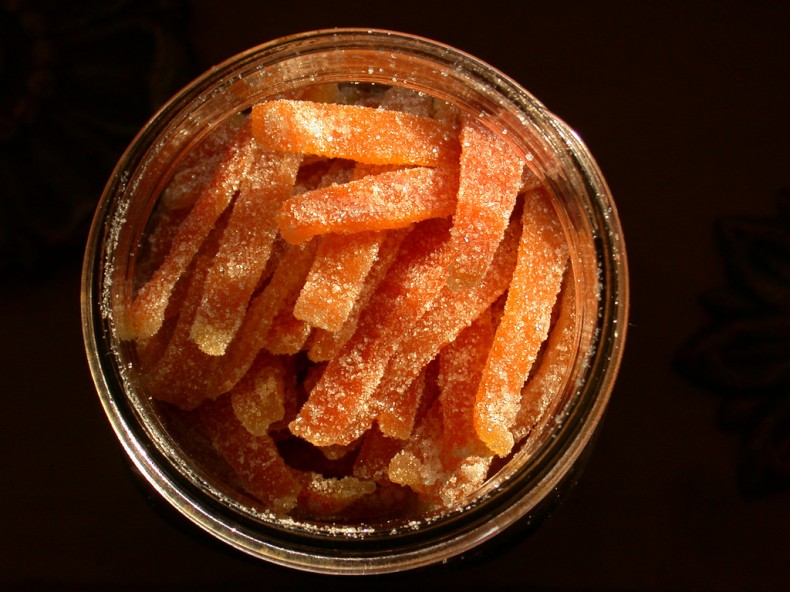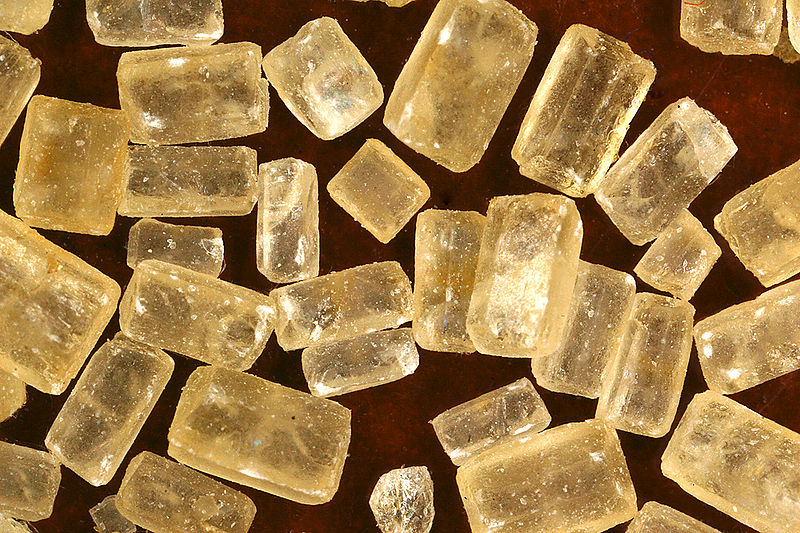
I’ve rerun this post before, I think the last time was 2019 and the time before was 2014. I rerun it again now because 1) my Hungarian neighbor/physicist/co-obsessive and I have just shared our nearly decade-old Google doc of orange-peel data with another neighbor/chemist/neutral party because 2) in spite of my fearlessness below, my last batches have been edible but not the least successful and in any case, resemble the Hungarian orange peels not at all, even though both I and my physicist-neighbor keep meticulous lab notes and carefully reproduce each others’ methods and so 3) we hope that a chemist will solve this non-replication problem. So far, the chemist says we’re all going to have to get into the kitchen together and he’s going to watch us control the hell out of every variable. We haven’t done that yet.
I’ve been making candied orange peel regularly for some time now and I say this fearlessly: I have nailed it. The second secret (the first is, never trust sugar chemistry), which I sensed only dimly when I first wrote this, back on May 15, 2014, is that the orange peels have to be thick and taken off the heat early: see the bottom of this post. They’ll still be thickly drippy and will bond to a china plate, so I let them cool on one plate, wrestle them out of their sugar puddles, move them to another plate, repeat until they stop bonding to the plates. The Hungarians do not keep them in the refrigerator; I do, but I have no good reason. A lot of fussing but it ends in revelation. Not that the universal forces can’t shift again and make the whole recipe useless.
#
The neighbors came over, maybe a year ago now, and one of them, a Hungarian physicist, brought along candied orange peel he’d made from his grandmother’s recipe. The physicist is the nicest human on earth, but his grandmother is the one I love; I’d love anyone who thought up those orange peels, their orangey goodness and little spike of bitter, the soft white sweet pith and the dense, bitey, red-golden skin. I had raptures all over the dining room table. “Yes, of course you can have the recipe,” said the physicist. “But I must tell you, you need to be careful how you make them.”
“Oh I know about sugar,” I said, and told him about the hot fudge sauce I made once and reheated twice, and the second time, it made a standing cage over the melted ice cream and when I ate it anyway, I chipped a tooth; and the little left in the pan had bonded to the metal and the pan had to be thrown away. So the physicist gave me the recipe and the most careful directions, and I made the orange peels and they were perfect, as good as any Hungarian grandmother’s. Then I made them many more times until suddenly, one day, some mysterious force in the universe shifted.

The recipe no longer works. I continue to control the hell out of the variables. I use the same amount of orange peel, two-oranges-worth, every time. I use the same 1:1 ratio of water to sugar and the same absolute amounts, 1.5 cups each. I use a pan of the same size, the same stingy amount of stirring, the same low simmer until the water gradually boils off and bubbles foam on top of bubbles, and no liquid remains. I get them out of the pan fast, spread them on plates, let them cool. They’re tooth-chippingly hard, they’re like glass. I throw out whole batches of them, though the Hungarian physicist says, on consult, that if he leaves one in his mouth it eventually melts. After an hour or something, maybe a whole afternoon. I am in despair, I can talk of nothing else.
The physicist thinks the glassiness/chewiness depends on the thickness of the orange peels and certainly that’s a variable I haven’t controlled. And physicists are usually right about everything, so he’s probably right. But I think it’s the chemistry of sugar: it’s complex and finicky, disturbingly so.
Dissolve sugar in water and heat until the water is driven off. [Digression: why fool with water, why not just heat the sugar? I did that once, put sugar in a pan, forgot to add water, turned on the heat, thought about something else for a while, and when I looked again at the pan, the sugar was a molten, golden syrup. Perfect. You think that ever happened again?] As the water leaves, the sugar solution gets more concentrated and hotter. [Digression on heat: the redoubtable Shirley Corriher says not to use lined copper pans, nonstick pans, or plastic stirring spoons because they’ll all melt; metal stirring spoons get too hot to touch.] As the solution heats and condenses, its texture changes. Drop a solution that’s 92% sugar into water and it forms a ball you can shape; drop a 95% solution into water, and it forms flexible threads; drop a 99% solution and the threads snap; and at 100% concentration, no water left, the solution goes from clear amber to brown to black, from 320 degrees to 350 degrees, quickly, so quickly, take your eyes off it, blink, it happened. You throw away the pan.
But sugar is not only complex, it’s iniquitous: you can’t believe those numbers. The modern kitchen scientist directs you to guide yourself through this process with a candy thermometer, but the also-redoubtable Harold McGee says that even in the lab, let alone in my kitchen, all those numbers “can vary quite widely and are notoriously inaccurate at higher temperatures.” In fact, don’t even believe the sugar. Corriher says that sucrose, when heated, breaks down into smaller sugars which recombine into different sugars which break down again into even different sugars, and by the time you’ve reached the black stage, you’ve gone through 128 different sugars, each with its own color, small, taste, chemical formula, and (I add) texture.
And now I’m outraged. All I want is candied orange peel, it’s not too much to ask, and instead I get this lethal complexity, this intricate villainy. Last time I just plain took the peels out of the pan before the water boiled away and they’re quite good but now I’ve got a wholly different problem: I apparently took them out too early because even cooled, dried, and refrigerated, they’re so sticky I have to surgically separate them from each other. So I complained again to the Hungarian physicist and he suggested I dip them in melted dark chocolate.
And now the miasma lifts, the despair clears. Chewy orange peels covered with dark chocolate. I am at peace with the universe.
__________
UPDATE: The Hungarian physicist did a noble experiment. He assumed I was right and in spite of the recipe having worked before, the peels could no longer now be boiled nearly dry. He took them out “when they were beginning to look a little glassy — how do you say that, glazed?” Me: “Glassy is perfect.” — and laid them out on a plate, not touching each other, and let them dry out for two days. I have replicated that experiment and get the same results. The physicist says, as he said before, that the key variable and the only variable that actually varies is the thickness of the orange peel.
__________
photo of candied orange peel by Jocelyn McAuley; and of sugar Sanjay Acharya
Is there a difference between cane sugar and beet sugar? Did you use a different sugar from time to time?
I don’t know the difference between different kinds of sugar. But I always use the same kind, Domino’s, because I’m a Baltimore girl.
Really enjoyed this Ann. Do you know “But the Crackling is Superb” an anthology on food and drink by Fellows and Foreign members of the Royal Society, edited by another Hungarian physicist Nicholas Kurti (with Giana Kurti) ? Kurti Specialised in low rather than high temperatures, but there are some great recipes and scientific and other approaches to food. No candied peel but a couple of recipes for marmalade.
I don’t know that book but I shall certainly look it up. My local Hungarian physicist will be interested too. Thank you, Adam!